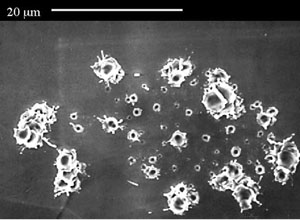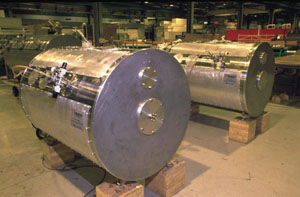Accelerators are increasingly turning to superconducting technology to transfer power to the particle beams. The biennial workshop is a shop window for progress.

Radiofrequency is the motive power of particle accelerators and, in the continuing bid for higher energies, superconducting techniques are increasingly being used to squeeze out the maximum number of electron volts from the available power.
The biennial Radiofrequency Superconductivity Workshop reflects this progress and focuses attention on new goals. The ninth workshop was organized by Los Alamos on 1-5 November 1999 at Santa Fe, New Mexico, under chairman Brian Rusnak. About 180 participants registered, a little fewer than the previous workshop, but with an ever-increasing participation of representatives from industry. The latter also presented their latest high-tech products – cavities, couplers, high-quality niobium and related fabrication tools.
The workshop began with operations and laboratory review talks. It opened with the achievements of the superconducting radiofrequency (RF) system for CERN’s LEP2 electron-positron collider, which is currently the largest system in the world with about 3500 MV of “superconducting voltage”.
The niobium film on copper (Nb/Cu) cavities clearly outperform the specified field gradient. This performance gives LEP beams of up to 102 GeV, a level that not even optimists could dare to dream of when the first modules were installed. Even above design specifications, the system runs very reliably and about 15 MW of RF power is regularly transmitted to the beam.

CEBAF, the continuous-wave electron-recirculating linac at the Jefferson Laboratory, Newport News, routinely delivers beams at 5.5 GeV, well above the 4 GeV that was originally specified.
ATLAS, the versatile heavy-ion accelerator in operation and extension at Argonne, the more recent ALPI at Legnaro and other smaller machines regularly accumulate superconducting cavity hours.
In Cornell’s CESR electron-positron collider, the four existing copper five-cell cavities have been replaced by four single-cell superconducting cavities, with strong higher-order mode damping to allow the beam current and luminosity to be increased significantly.
The international TESLA project
Many advances in production and material testing result from the international TESLA project and its test facility at DESY (working as a free electron laser).
R&D continues to yield dividends. The spinning of a whole multicell cavity from a seamless tube, and non destructive metal sheet probing (for example, to detect a foreign metal by the tiny magnetic field of the thermocurrent produced when a localized area of a niobium sheet is heated), were reported.
The stiffening of cavities – to reduce Lorentz force deformation and detuning – with external thermal copper spraying was examined. Controlling these pulsed cavities in amplitude and phase to maintain beam quality is not trivial. However, a working system, using digital controllers with feedback and feed-forward, has been built and tested successfully.
A more difficult task will be the control and operation of the proposed superstructure of four seven-cell cavities, connected by short beam pipes and driven by a single power coupler at one end.
The nine-cell TESLA design accelerating gradient of 25 MV/m has become routine at the test facility. Even better, single-cell lab tests at different places approach gradients of close to 40 MV/m.
Until recently, electropolished and buffered chemically polished cavities seemed to show the same performance, the latter method being simpler. However, already advertised by the Japanese KEK Lab at the last workshop, electropolishing shows higher gradients and the “holy” heat treatment at about 1400 ºC becomes redundant.
High-pressure water rinsing has become a standard finishing surface treatment, and other liquids – for example, detergents – have been proposed. Also, a weak bakeout at only 145 ºC improved a cavity significantly. The progress is still encouraging.
These achievements are complemented by a better understanding of the superconducting surface. A major effort for the Nb/Cu cavities at CERN has given a better picture of the influence of RF and external magnetic fields responsible for the decrease of the resonance Q-value with higher RF field (Q-slope). This Q-slope makes today’s Nb/Cu cavities – the thermal stability of which is otherwise very attractive – non-competitive for very high gradients.
A parallel effort correlated copper surface treatment and film production parameters – for example, using different noble gases for sputtering – with their composition and RF performance.
A quadrupole-resonator test cavity has been built to probe surface resistance. The Q-slope is also present in a weaker form for the solid niobium cavities, so several models have been proposed to explain the effect. However the jury is still out.
Improvements
High-power couplers – several with adjustable coupling – have been improved at many laboratories. All of them reach the several hundred kilowatt range in continuous-wave operation at frequencies between 350 MHz and 1.3 GHz.
After a successful application in LEP, most coaxial couplers include an option for DC bias voltage to suppress multipacting. Despite their increased performance, power couplers remain the bottleneck in high-current machines, limiting the useful cavity gradient to far below today’s possibilities.
For CERN’s LHC 400 MHz single-cell cavities, the operational gradient is only 5.5 MV/m. All 21 bare cavities have been fabricated by industry with proven LEP2 Nb/Cu technology. They have all been tested successfully, ready for assembly into cryomodules.
Accelerated electrons become relativistic very soon in a linac, but the much heavier protons are significantly slower than the velocity of light in much of the machine. Thus, modified spherical cavity shapes with reduced cell length (reduced beta cavities) have been designed, built and successfully tested at several laboratories for high current proton machines. (At CERN’s LHC, the protons will already become relativistic in the injection chain.)
The Q-value and accelerating gradient of these cavities is intrinsically lower compared with cavities for fully relativistic beams. Despite lower accelerating gradients, a high-quality superconducting surface is as important here as it is for high-gradient cavities.
There are several studies for new high-current proton linacs in the range of a few hundred mega-electron volts to 1-2 GeV – for spallation sources or nuclear waste transmutation – that have a normal conducting and a superconducting option. The proven reliability of today’s large superconducting RF systems – running for many months without real interruption – should help to convince funding agencies of the value of the latter option.
The last day of the workshop looked at projects like the TESLA linear collider proposal and an upgrade of CEBAF to 12 GeV, and possibly to 30 GeV. After LEP is closed, the LEP2 RF system could be recommissioned in an Electron Laboratory for Europe recirculating-electron linac project. Even a possible muon collider with superconducting RF was presented.
The tenth workshop will be held in 2001 in Japan and will be organized jointly by JAERI and KEK. The chairperson will be Shunichi Noguchi from KEK. The community is already convinced that there will be a lot more to report.





